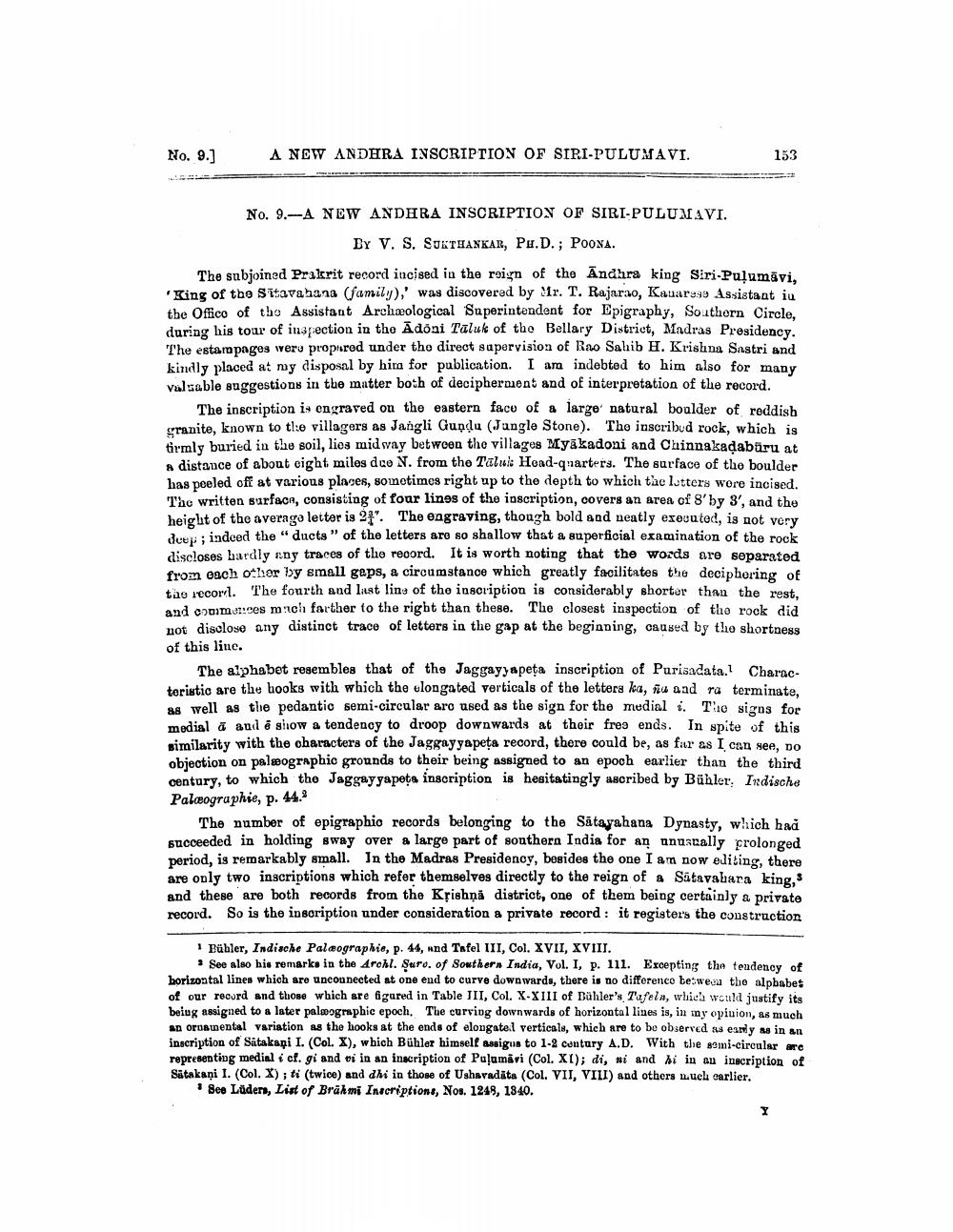________________
No. 9.]
A NEW ANDHRA INSCRIPTION OF SIRI-PULUMAVI.
153
No. 9.-A NEW ANDHRA INSCRIPTION OF SIRI-PULUMAVI. BY V. S. SURTHANKAR, PH.D.; POONA.
The subjoined Prakrit record incised in the reign of the Andhra king Siri-Puļumāvi, 'King of the Sitavahana (family),' was discovered by Ir. T. Rajarao, Kauarese Assistant iu the Office of the Assistant Archaeological Superintendent for Epigraphy, Southern Circle, during his tour of inspection in the Adoni Taluk of the Bellary District, Madras Presidency. The estampages were propared under the direct supervision of Rao Sahib H. Krishna Sastri and kindly placed at my disposal by him for publication. I am indebted to him also for many valuable suggestions in the matter both of decipherment and of interpretation of the record.
The inscription is engraved on the eastern face of a large natural boulder of reddish granite, known to the villagers as Jangli Gundu (Jungle Stone). The inscribed rock, which is firmly buried in the soil, lies midway between the villages Myakadoni and Chinnakaḍabāru at a distance of about eight miles due N. from the Taluk Head-quarters. The surface of the boulder has peeled off at various places, sometimes right up to the depth to which the letters were incised. The written surface, consisting of four lines of the inscription, covers an area of 8' by 3', and the height of the average letter is 2". The engraving, though bold and neatly executed, is not very deep; indeed the "ducts" of the letters are so shallow that a superficial examination of the rock discloses hardly any traces of the record. It is worth noting that the words are separated from each other by small gaps, a circumstance which greatly facilitates the deciphering of the record. The fourth and last line of the inscription is considerably shorter than the rest, and commences much farther to the right than these. The closest inspection of the rock did not disclose any distinct trace of letters in the gap at the beginning, caused by the shortness of this line.
The alphabet resembles that of the Jaggayyapeta inscription of Purisadata. Characteristic are the books with which the elongated verticals of the letters ka, na and ra terminate, as well as the pedantic semi-circular are used as the sign for the medial . The signs for medial a and é show a tendency to droop downwards at their free ends. In spite of this similarity with the characters of the Jaggayyapeta record, there could be, as far as I can see, no objection on palæographic grounds to their being assigned to an epoch earlier than the third century, to which the Jaggayyapeta inscription is hesitatingly ascribed by Bühler, Indische Paleographie, p. 44.
The number of epigraphic records belonging to the Satayahana Dynasty, which had succeeded in holding sway over a large part of southern India for an unusually prolonged period, is remarkably small. In the Madras Presidency, besides the one I am now editing, there are only two inscriptions which refer themselves directly to the reign of a Satavahara king,s and these are both records from the Krishna district, one of them being certainly a private record. So is the inscription under consideration a private record: it registers the construction
1 Bühler, Indische Palæographie, p. 44, and Tafel III, Col. XVII, XVIII.
See also his remarks in the Archl. Suro. of Southern India, Vol. I, p. 111. Excepting the tendency of horizontal lines which are unconnected at one end to curve downwards, there is no difference between the alphabet of our record and those which are figured in Table III, Col. X-XIII of Bühler's, Tafeln, which would justify its being assigned to a later paleographic epoch. The curving downwards of horizontal lines is, in my opinion, as much an ornamental variation as the hooks at the ends of elongatel verticals, which are to be observed as early as in an inscription of Satakapi I. (Col. X), which Bühler himself assigns to 1-2 century A.D. With the semi-circular are representing medial i cf. gi and vi in an inscription of Pulumavi (Col. XI); di, ni and hi in an inscription of Satakaṇi I. (Col. X); ti (twice) and dhi in those of Ushavadata (Col. VII, VIII) and others much earlier.
* See Lüders, List of Brahmi Inscriptions, Nos. 1248, 1840.
I




